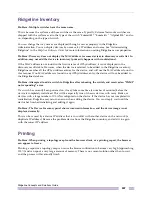
Book Title
Ridgeline Concepts and Solutions Guide
310
Setting Ridgeline as a Trap Receiver
When Extreme devices are added to the Ridgeline inventory, they are automatically configured to send
traps to the Ridgeline server. However, third-party devices are not automatically configured to do so.
If you want alarms to function for third-party devices, you must manually configure the devices to send
traps to the Ridgeline server.
The information required to set up Ridgeline as a trap receiver is the following:
●
The IP address of the system where the Ridgeline server is running.
●
The Ridgeline server trap port. By default this is 10550. (This is set in the properties file
extreme.properties
, found in the
<
Ridgeline_installdir>/extreme.war
subdirectory).
●
The Ridgeline server community string. This is a string in the form:
ST.<
value of IP address
>.<
value of trap port
>
The value of the IP address is the decimal equivalent of the hex value of the IP address.
For example, if the IP address of the Ridgeline server is
10.0.4.1
, you would calculate the decimal
equivalent by doing the following:
a
Convert each quad of the IP address to its hex equivalent:
b
Convert the hex value
a000401
into a decimal value, in this case
167773185
c
Put the three components together to form the community string:
ST.167773185.10550
You can find and verify the value of the community string by using Telnet to log into an Extreme
Networks device that is being managed by Ridgeline, and using the ExtremeWare CLI command
show management
to display the list of trap receivers configured for that device. The Ridgeline
server, and its community string, should be included in this list.
To receive RMON traps, you need to ensure that RMON is enabled on the device. For Extreme devices,
you can do this through the ExtremeWare CLI with the command
enable rmon
.
The Ridgeline Third-party Device Integration
Framework
Ridgeline’s third-party device integration framework provides a generic mechanism for adding
third-party device support with a minimum of configuration changes. While Ridgeline has always been
able to discover any device running an agent that supports MIB-2, the functionality provided was
minimal.
The Ridgeline integration framework enables more extensive support:
●
Basic feature support, including front and back panel views if available
●
Third-party device trap support
Decimal
Hex
10
a
0
00
4
04
1
01
Summary of Contents for Ridgeline 3.0
Page 14: ...Related Publications Ridgeline Concepts and Solutions Guide 12 ...
Page 26: ...Ridgeline Overview Ridgeline Concepts and Solutions Guide 24 ...
Page 52: ...Getting Started with Ridgeline Ridgeline Concepts and Solutions Guide 50 ...
Page 78: ...Using Map Views Ridgeline Concepts and Solutions Guide 76 ...
Page 88: ...Provisioning Network Resources Ridgeline Concepts and Solutions Guide 86 ...
Page 103: ...6 Ridgeline Concepts and Solutions Guide 101 Figure 63 E Line Service Details Window ...
Page 104: ...Managing Ethernet Services Ridgeline Concepts and Solutions Guide 102 ...
Page 114: ...Importing Services Ridgeline Concepts and Solutions Guide 112 ...
Page 132: ...Managing and Monitoring VPLS Domains Ridgeline Concepts and Solutions Guide 130 ...
Page 146: ...Managing VLANs Ridgeline Concepts and Solutions Guide 144 ...
Page 190: ...Managing Your EAPS Configuration Ridgeline Concepts and Solutions Guide 188 ...
Page 202: ...Managing Network Security Ridgeline Concepts and Solutions Guide 200 ...
Page 350: ...Book Title Ridgeline Concepts and Solutions Guide 348 ...
Page 372: ...Book Title Ridgeline Concepts and Solutions Guide 370 ...
















































